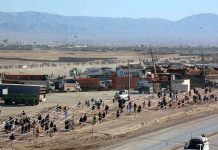
Umerkot: Dost Muhammad, 60, a laborer of Tharparkar district is waiting for the day when he would be able to walk in his village in the night that would not be dark due to unavailability off electricity. He spends nights at home with oil-lamps and candles.
“We have been facing numerous problems since birth. We are unable to walk in the dark at night, let alone work. It is very difficult for us to drag out water out of 300 feet of deep well. It is like the dark ages,” Muhammad, a resident of village Tharyo Halepoto in Thar Coal block-II, told News Lens Pakistan.
He said that the government is responsible for their plight. Out of 2350 villages, (according to the 1998 census) only 4 percent of these villages have access to electricity, which is a miniscule number. Electricity is a basic necessity and its absence affects their working conditions, educational institutions, hospitals (electricity needed to run medical equipment) and day-to-day life. All these problems are linked to the unavailability of electricity, and the community is close to coming at a standstill.
Another village teacher, Wasayo told News Lens Pakistan, “The first time bulb was lighted up was in Mithi city during the mid-1980s.” He said that winds blow fast and there is an increase in wind erosion. The sun is scorching, and causes illnesses such as heatstroke and dehydration amongst the locals. The residents are poor, and cannot utilize these natural resources for the production of energy. Thar coal is said to be ready to pollute their environment and displace them, he added.
A female health worker, Fatima Sand, a resident of village Chhachhro in district Tharparkar, said, “Living in the darkness is hard. After sunset some of them use oil lamps, affecting the environment of their homes. Maintaining a cold chain of life saving medicines, recharging cell phones/communication sources, dragging out water from deep wells or pump water for miles away from source, and providing computer education in schools is still a dream for most of the population living in Thar because it all needs electricity, but the government has other priorities.”
“Even after 68 years, it is difficult for the locals to imagine their settlement connected to the grid and having electricity to make life easier,” she said.
According to PPP’s Senator Taj Haider, who is also a development expert, there is a very thin network of connected grids that provide electricity. It is hard to reach remote areas that have a difficult terrain and scattered population, such as mountainous and desert areas. Therefore, he repeatedly advised the government to build model villages at one place, as it will be easier to provide basic amenities,
Ali Akbar Rahimoo, a development expert working on renewable energy in Thar, said, “Luckily, mountainous area of Sindh and Balochistan as well as the desert of Thar and Cholistan of Punjab and Sindh are rich in solar energy. Coastal areas of Sindh and Balochistan have high potential for wind energy. Sand dunes of Thar are also rich in geothermal energy. Unfortunately, the government has been focusing on conventional sources of electricity generation such as coal and oil, but rarely focuses on harnessing renewable energy sources such as solar, tidal and wind energy.”
“A few projects of wind energy are being developed in Sindh province and one mega solar project of Jinnah Solar Park is being developed in Cholistan. Federal government and the Sindh provincial government have recently started blaming each other, claiming that Sindh based renewable energy projects are not being developed and executed due to obstacles placed by the other party,” he also added.
A social activist, Gotam Rathi, says despite the absence of renewable energy friendly laws, policies and financial assistance; some initiatives are being taken by NGOs in Thar and these efforts have been fruitful in making the locals’ lives easier.
Solar energy is being used to drag out water from a depth of 300 feet, solar PV systems are being used to illuminate homes in the deep desert, traditional birth attendants are using systems for illuminating homes at night for performing their jobs of delivering babies as well as charging cell phones to build contact with ambulance service providers. Students are being taught on computers and have the facility to read at home after sunset. Artisan women have the opportunity to make traditional embroidery items after sundown.
According to an environmentalist, Bharumal Amrani, a lot of developed countries are focusing on the promotion of renewable energy sources because they are environmentally friendly with minimal waste. Underdeveloped areas are rich in renewable energy, but no one focuses on them. IFIs and MNCs are focusing on Thar coal and other mega projects. Crude oil is being imported and coal based power plants are being promoted; they are not environmentally friendly while also being costly and they are not renewable- they will eventually run out.
An ‘off grid’ concept is being encouraged, which also cuts down loss of electricity through damaged power lines. A devolved power system will be easier to install, maintain and sustain.
Din Muhammad Dars, a student, told News Lens Pakistan that an NGO has provided them with solar energy to run fans and computers as well as solar lights. These lights are charged by sunlight at school and, their homes have been illuminated with the same solar lights, which is where they study, while their females carry out their embroidery work.



